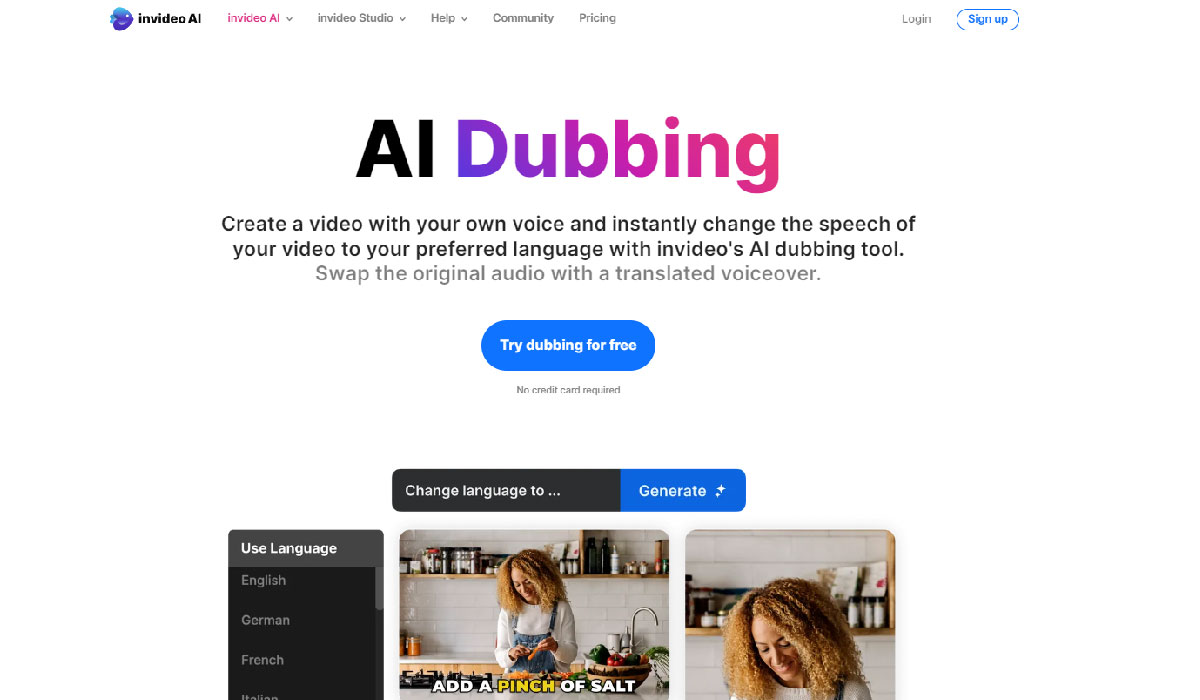In the modern digital age, video content reigns supreme. Every day, millions of videos are watched by people all over the world, from YouTube to Netflix. However, one of the most difficult obstacles for content providers is making their videos accessible to a global audience. Language constraints can reduce the reach and impact of even outstanding material. AI video dubbing is a new technology that is changing the way producers produce and share their videos.
What is AI Video Dubbing?
AI video dubbing is the process of automatically translating and synchronizing a video’s audio into many languages. Unlike traditional dubbing, which requires human voice actors and may be time-consuming and costly, AI video dubbing uses advanced machine learning algorithms to generate high-quality dubbed audio quickly and efficiently.
AI video dubbing systems analyze the original audio, transcribe the spoken words, translate the text into the target language, and then construct synthetic voices that correspond to the translated script. These technologies can even emulate the tone and emotion of the original speakers, giving viewers a more authentic and engaging experience.
The Benefits of AI Video Dubbing:
1. Cost-effective
Traditional dubbing necessitates the employment of voice actors, translators, and sound engineers, which can be expensive, particularly for authors on a tight budget. AI video dubbing drastically cuts expenses by automating the majority of the process. This makes it accessible to independent individuals and small businesses who want to reach worldwide audiences without breaking the bank.
2. Time-Saving
Manual dubbing is not only expensive but also time-consuming. Scheduling voice actors, recording sessions, and post-production editing might take weeks or even months. AI video dubbing, on the other hand, can generate dubbed audio in a fraction of the time, allowing artists to upload their material more quickly and frequently.
3. Scalability
Traditional dubbing processes can be difficult to scale for creators who produce a significant volume of content. AI video dubbing provides a scalable method, allowing artists to dub several videos simultaneously without sacrificing quality. This scalability is especially useful on platforms like YouTube, where content providers must keep up with strong demand and regular updates.
4. Consistency
Human voice actors’ performance can vary, resulting in variations in tone and delivery across multiple videos. AI video dubbing maintains a consistent voice and tone, delivering an even viewing experience for the viewer. This consistency is critical for establishing a strong brand identity and retaining viewer trust.
For more information, click here: DeepBrain AI
How Does AI Video Dubbing Work?
Step 1: Speech Recognition
The initial phase in AI video dubbing is speech recognition, which involves the AI system transcribing the original audio into text. Advanced speech recognition algorithms can catch spoken words properly, even in loud situations or with strong accents. This transcription serves as the basis for the translation process.
Step 2: Translation
Once the audio has been transcribed, the next stage is translation. The artificial intelligence system uses machine translation models to translate the recorded text into the target language. These models are trained on large datasets of multilingual text, allowing them to create accurate and context-appropriate translations.
Step 3: Voice Synthesis
Following translation, the AI system creates synthetic voices to read the translated texts. Voice synthesis, or text-to-speech (TTS), translates translated text into a natural-sounding voice. Modern TTS systems can mimic many speech qualities, such as pitch, speed, and intonation, to match the real speaker’s tone.
Step 4:Lip Syncing
Ensure audio syncs with video, which is a tough component of dubbing. AI video dubbing systems use complex algorithms to match the synthetic speech to the lip movements in the original video. This procedure, known as lip-syncing, results in a smooth viewing experience in which the dubbed audio appears to be uttered organically by the on-screen characters.
Real-World Applications of AI Video Dubbing:
1. Entertainment Industry
The entertainment sector is one of the most significant beneficiaries of AI video dubbing. Streaming services such as Netflix and Amazon Prime Video can employ AI dubbing to make their content available to worldwide audiences rapidly and affordably. This not only improves viewership but also helps to retain subscribers by providing a variety of language alternatives.
2. Educational content
Educational content makers can use AI video dubbing to reach a worldwide audience. By dubbing their movies into other languages, they can deliver useful knowledge and resources to learners all across the world. This is especially significant in online education because language restrictions might limit access to high-quality educational materials.
3. Corporate Training
AI video dubbing can help global firms streamline training operations. By dubbing training films into other languages, businesses can ensure that all employees, regardless of location, receive the same level of training. This encourages consistency and contributes to the maintenance of high standards throughout the organization.
4. Marketing and Advertising
Marketers can utilize AI video dubbing to generate locally tailored-commercials and promotional movies. Businesses can efficiently target varied customers and expand the reach of their brands by dubbing advertisements into multiple languages. This localization can increase engagement and conversion rates since consumers are more likely to respond positively to material in their native language.
The Future of AI Video Dubbing
AI video dubbing’s future appears hopeful, because of continued breakthroughs in AI and machine learning technologies. As AI systems advance, we should expect even greater accuracy in speech detection, translation, and voice synthesis. Furthermore, the use of deep learning techniques will allow AI video dubbing systems to better recognize context and nuances, resulting in more natural and fluent translations.
Furthermore, AI video dubbing is expected to become more accessible and user-friendly. We may expect the development of simple tools and platforms that will allow creators to simply dub their videos without requiring technical knowledge. These tools will enable more producers to create multilingual material, broadening access to global audiences.
Conclusion
AI video dubbing is ushering in a new era of video production, providing producers with unique ways to overcome language boundaries and broaden their reach. By using the power of artificial intelligence, producers may make high-quality dubbed videos rapidly, cost-effectively, and at scale. Whether you’re an individual YouTuber, an instructor, a corporate trainer, or a marketing, AI video dubbing can help you reach a worldwide audience and increase the impact of your material.
As technology advances, AI video dubbing will certainly become a valuable tool for content makers. Embrace the new era of video production and discover the limitless possibilities that AI video dubbing provides.















